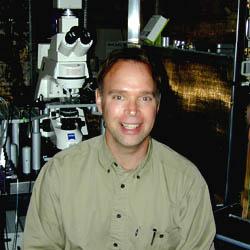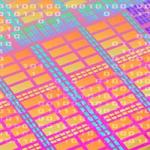
Research Topics
Research in this section is directed toward understanding brain mechanisms underlying the generation and control of innate motor behavior in the mammalian CNS. One of the fundamental challenges in contemporary neuroscience is to explain the generation of behavior in terms of the cellular and neural network properties of neural systems. Networks generating movement, particularly those producing innate rhythmic motor behaviors such as breathing and locomotion, provide important model systems to address this problem. We study brainstem networks producing rhythmic breathing movements. Our long-range goal is to explain the neurogenesis of respiratory movements at the molecular, biophysical, synaptic, and network levels. The respiratory network is one of the few neural systems that can generate behaviorally relevant patterns of neural activity in highly reduced preparations of the mammalian CNS. This attribute has enabled us to develop unique in vitro preparations (e.g. see Koshiya and Smith, 1999), including brain slice preparations, that retain active respiratory networks, allowing concurrent measurements at cellular, synaptic, and network levels in the context of behaviorally meaningful network activity.
Our current in vitro studies focus mainly on mechanisms generating the neural oscillation underlying the rhythm of breathing. We are conducting interrelated studies to determine biophysical properties, morphology, network architecture, and synaptic interactions of the rhythm-generating neurons in the pre-Botzinger complex, the brainstem locus of rhythm generation (Smith et al., Science 254: 726-729, 1991). Our experimental techniques include whole-cell patch-clamp recording for studies of biophysical and synaptic properties, infrared and fluorescence videomicroscopy for real-time imaging of single cell and neuron population activity with calcium-sensitive dyes (Koshiya and Smith, 1999), and computational modeling of neurons, synapses, and networks (Butera et al., 1999).
Biography
Selected Publications
- Smith JC, Abdala AP, Koizumi H, Rybak IA, Paton JF. Spatial and functional architecture of the mammalian brain stem respiratory network: a hierarchy of three oscillatory mechanisms. J Neurophysiol. 2007;98(6):3370-87.
- Smith JC, Abdala AP, Borgmann A, Rybak IA, Paton JF. Brainstem respiratory networks: building blocks and microcircuits. Trends Neurosci. 2013;36(3):152-62.
- Richter DW, Smith JC. Respiratory rhythm generation in vivo. Physiology (Bethesda). 2014;29(1):58-71.
- Phillips RS, John TT, Koizumi H, Molkov YI, Smith JC. Biophysical mechanisms in the mammalian respiratory oscillator re-examined with a new data-driven computational model. Elife. 2019;8.
- Sheikhbahaei S, Turovsky EA, Hosford PS, Hadjihambi A, Theparambil SM, Liu B, Marina N, Teschemacher AG, Kasparov S, Smith JC, Gourine AV. Astrocytes modulate brainstem respiratory rhythm-generating circuits and determine exercise capacity. Nat Commun. 2018;9(1):370.
Related Scientific Focus Areas


Biomedical Engineering and Biophysics
View additional Principal Investigators in Biomedical Engineering and Biophysics

This page was last updated on Wednesday, January 4, 2023